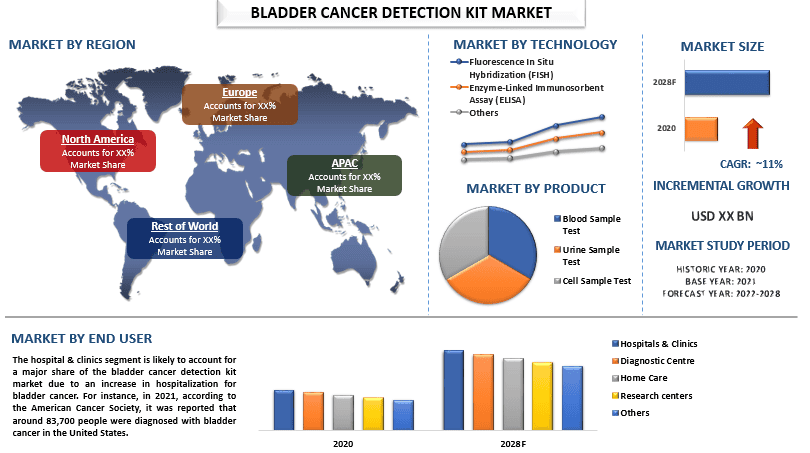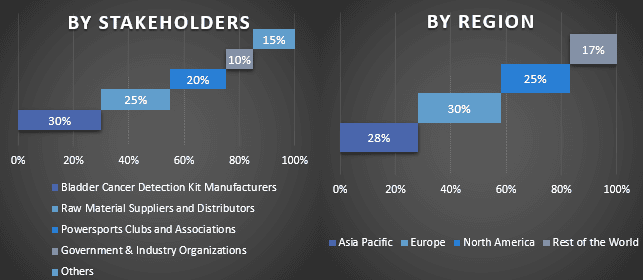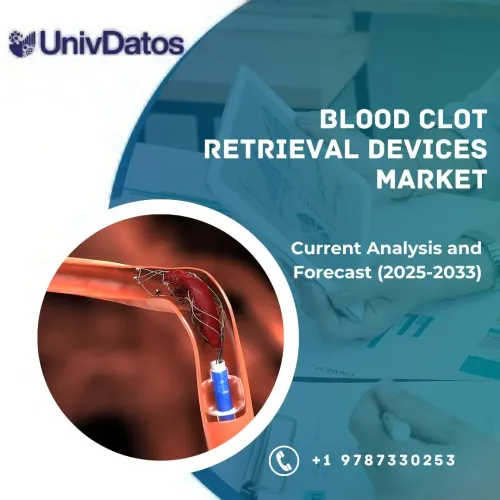膀胱がん検出キット市場:現状分析と予測(2022年~2028年)
技術重視(蛍光in situハイブリダイゼーション(FISH)、酵素結合免疫吸着測定法(ELISA)、その他)、種類(血液サンプル検査、尿サンプル検査、細胞サンプル検査)、エンドユーザー(病院および診療所、診断センター、在宅ケア、研究センター、その他)、地域/国

世界の膀胱がん検出キット市場は、予測期間中に約11%の高い成長率で成長すると予想されています。 これは主に、膀胱がんの罹患率の増加、がんとその利用可能な治療法に関する意識の向上、医療費の増加、喫煙およびタバコの消費の拡大が、膀胱がん検出キット市場の加速に寄与すると予想されるためです。Globocanによると、膀胱がんの世界的な負担は著しく高く、新規がん診断の3.0%、2020年のがん死亡の2.1%を占め、世界で11番目に多く診断されるがんです。 したがって、政府当局は膀胱がん検出キット関連製品の開発を鋭意注視しています。さらに、主要プレーヤーが研究開発活動や製品承認などのさまざまな成長戦略に注力することで、市場の拡大がさらに期待されます。したがって、主要な関係者による技術的に高度な膀胱がん検出キットの研究開発への注力と投資の増加が、市場のさらなる成長につながると予想されます。
Cepheid、BIOSYNEX SA、Abbott Laboratories、EXACT Sciences Corporation、Abingdon Health PLC、Xiamen Biotime Biotechnology Co., Ltd.、IDL Biotech AB、Alfa Scientific Designs、Biomerica Inc、Hologic Inc.などが、市場の主要プレーヤーです。ハイテクで革新的な製品/技術で顧客を支援するために、これらのプレーヤーによっていくつかのM&Aがパートナーシップとともに行われています。
レポートで提示される洞察
「技術別では、蛍光in situハイブリダイゼーション(FISH)カテゴリーが予測期間中に大きなCAGRを示す」
種類に基づいて、市場は蛍光in situハイブリダイゼーション(FISH)、酵素結合免疫吸着測定法(ELISA)、その他に分類されます。蛍光in situハイブリダイゼーション(FISH)カテゴリーは、予測期間中に大きなCAGRを示しました。このセグメントは、尿中に検出された尿路上皮細胞の遺伝的異常を検出するために、蛍光直接標識DNAプローブを使用する独自の尿検査技術であるため、主導的な役割を果たすと予想されます。
「エンドユーザー別では、病院および診療所が2020年に市場で大きなシェアを占める」
エンドユーザーに基づいて、市場は病院および診療所、診断センター、在宅ケア、研究センター、その他に分類されます。これらのうち、病院および診療所が2020年に市場で大きなシェアを占めます。病院インフラにおける膀胱がん検出キット市場は、世界的にイノベーションによって牽引されています。さらに、がんの検出および治療病院を建設する投資家は、膀胱がん市場を活用しています。
「北米が市場で大きなシェアを占める」
2020年、北米は世界の膀胱がん検出キット市場で大きなシェアを占めました。これは主に、地域全体で膀胱がんの有病率が上昇していることが、北米の膀胱がん検出キット市場を牽引しているためです。米国がん協会によると、2020年には米国で約83,730件の膀胱がんの新規症例と約17,200件の膀胱がんによる死亡が発生しました。 さらに、これらの地域における膀胱がん検出キット市場の発展は、研究開発投資の増加、医療インフラの改善、および政府の取り組みの増加によってさらに支えられると予想されます。有病率と死亡率が世界中で上昇しているため、膀胱がん診断の需要が高まっています。これにより、非侵襲的な膀胱がん検出製品の研究開発への投資がさらに増加し、膀胱がん検出キット市場の成長が促進されます。
このレポートを購入する理由:
- この調査には、認証された主要な業界専門家によって検証された市場規模と予測分析が含まれています。
- レポートは、業界全体のパフォーマンスの簡単なレビューを一目で示しています。
- レポートは、主要な事業財務、製品ポートフォリオ、拡大戦略、および最近の開発に重点を置いて、著名な業界ピアの詳細な分析をカバーしています。
- 業界で蔓延している推進要因、制約、主要な傾向、および機会の詳細な調査。
- この調査では、さまざまなセグメントにわたる市場を包括的にカバーしています。
- 業界の地域レベルの詳細な分析。
カスタマイズオプション:
グローバル膀胱がん検出キット市場は、要件またはその他の市場セグメントに応じてさらにカスタマイズできます。これに加えて、UMIはお客様独自のビジネスニーズがあることを理解しているため、お客様の要件に完全に適合するレポートを入手するために、お気軽にお問い合わせください。
目次
膀胱がん検出キット分析の調査方法(2022年~2028年)
世界の膀胱がん検出キット市場の過去の市場を分析し、現在の市場を推定し、将来の市場を予測することは、世界の主要地域における膀胱がん検出キットの採用を構築および分析するために行われた3つの主要なステップでした。過去の市場数値を収集し、現在の市場規模を推定するために、徹底的な二次調査が実施されました。次に、これらの洞察を検証するために、多数の調査結果と仮定が考慮されました。さらに、世界の膀胱がん検出キット市場のバリューチェーン全体にわたる業界の専門家との徹底的な主要インタビューも実施されました。主要なインタビューを通じて市場数の仮定と検証後、完全な市場規模を予測するために、トップダウン/ボトムアップアプローチを採用しました。その後、市場の細分化とデータの三角測量方法を採用して、業界のセグメントおよびサブセグメントの市場規模を推定および分析しました。詳細な方法論を以下に説明します。
過去の市場規模の分析
ステップ1:二次資料の詳細な調査:
年次報告書および財務諸表、業績プレゼンテーション、プレスリリースなどの企業内部資料、およびジャーナル、ニュースおよび記事、政府刊行物、競合他社の刊行物、セクターレポート、サードパーティデータベース、およびその他の信頼できる刊行物などの外部資料を通じて、膀胱がん検出キット市場の過去の市場規模を取得するために、詳細な二次調査が実施されました。
ステップ2:市場のセグメンテーション:
膀胱がん検出キット市場の過去の市場規模を取得した後、主要地域のさまざまなセグメントおよびサブセグメントの過去の市場の洞察とシェアを収集するために、詳細な二次分析を実施しました。主要なセグメントは、テクノロジー、タイプ、およびエンドユーザーとしてレポートに含まれています。さらに、その地域におけるテストモデルの全体的な採用を評価するために、国レベルの分析が実施されました。
ステップ3:要因分析:
さまざまなセグメントおよびサブセグメントの過去の市場規模を取得した後、膀胱がん検出キット市場の現在の市場規模を推定するために、詳細な要因分析を実施しました。さらに、膀胱がん検出キットの生産のためのR&D活動への投資の増加などの従属変数と独立変数を使用して、要因分析を実施しました。トップパートナーシップ、M&A、事業拡大、および世界中の膀胱がん検出キット市場セクターにおける製品の発売を考慮して、需要と供給側のシナリオについて徹底的な分析を実施しました。
現在の市場規模の推定と予測
現在の市場規模の算定:上記の3つのステップからの実行可能な洞察に基づいて、現在の市場規模、世界の膀胱がん検出キット市場の主要なプレーヤー、およびセグメントの市場シェアに到達しました。必要な割合のシェア分割と市場の内訳はすべて、上記の二次的アプローチを使用して決定され、主要なインタビューを通じて検証されました。
推定と予測:市場の推定と予測のために、利害関係者が利用できる推進要因とトレンド、制約、および機会を含むさまざまな要因に重みが割り当てられました。これらの要因を分析した後、関連する予測手法(つまり、トップダウン/ボトムアップアプローチ)を適用して、世界の主要市場全体でさまざまなセグメントおよびサブセグメントの2028年の市場予測に到達しました。市場規模の推定に採用された調査方法論には以下が含まれます。
- 収益(米ドル)の観点から見た業界の市場規模、および国内の主要市場全体での膀胱がん検出キット市場の採用率
- 市場セグメントおよびサブセグメントのすべての割合のシェア、分割、および内訳
- 提供される製品の観点から見た、世界の膀胱がん検出キット市場の主要なプレーヤー。また、この急速に成長している市場で競争するためにこれらのプレーヤーが採用した成長戦略
市場規模とシェアの検証
一次調査:主要地域全体で、トップレベルのエグゼクティブ(CXO/VP、営業部長、マーケティング部長、オペレーション部長、地域部長、カントリー部長など)を含むキーオピニオンリーダー(KOL)との詳細なインタビューが実施されました。次に、一次調査の結果を要約し、述べられた仮説を証明するために統計分析を実行しました。一次調査からの入力は二次的な調査結果と統合されたため、情報が実行可能な洞察に変わりました。
さまざまな地域における主要な参加者の分割

市場エンジニアリング
データ三角測量手法を採用して、全体的な市場推定を完了し、世界の膀胱がん検出キット市場の各セグメントおよびサブセグメントの正確な統計数値に到達しました。データは、世界の膀胱がん検出キット市場におけるテクノロジー、タイプ、およびエンドユーザーの分野におけるさまざまなパラメーターとトレンドを調査した後、いくつかのセグメントおよびサブセグメントに分割されました。
世界の膀胱がん検出キット市場調査の主な目的
世界の膀胱がん検出キット市場の現在および将来の市場動向が調査で指摘されました。投資家は、調査で実施された定性的および定量的分析に基づいて、投資に対する裁量に基づいて戦略的な洞察を得ることができます。現在および将来の市場動向は、地域レベルでの市場の全体的な魅力を決定し、産業参加者が未開拓の市場を利用して、先行者利益から恩恵を受けるためのプラットフォームを提供しました。調査のその他の定量的な目標は次のとおりです。
- 価値(米ドル)の観点から見た膀胱がん検出キット市場の現在および予測市場規模を分析します。また、さまざまなセグメントおよびサブセグメントの現在および予測市場規模を分析します
- 調査のセグメントには、テクノロジー、タイプ、およびエンドユーザーの分野が含まれます。
- 膀胱がん検出キットの規制フレームワークの定義と分析
- さまざまな仲介業者の存在に伴うバリューチェーンを分析するとともに、業界の顧客および競合他社の行動を分析します。
- 主要地域の膀胱がん検出キット市場の現在および予測市場規模を分析します。
- レポートで調査された地域の主要国には、アジア太平洋、ヨーロッパ、北米、および世界のその他の地域が含まれます。
- 膀胱がん検出キット市場の企業プロファイル、および急速に成長している市場で持続するために市場プレーヤーが採用した成長戦略
- 業界の地域レベルの分析を深めます
関連 レポート
この商品を購入したお客様はこれも購入しました










